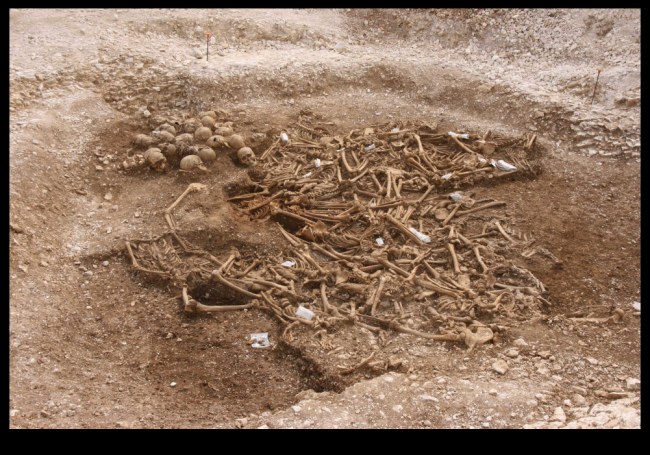Vikings Vikinged in Dorset UK March 29, 2011
Author: Beach Combing | in : Medieval, Prehistoric , trackbackBeachcombing has sometimes confessed in this place that he is not a great fan of the Vikings. Indeed, say ‘Viking’ to your average medievalist and they will get lyrical about sturdy boats and trips to Greenland. Beachcombing, on the other hand, sees burnt monastic libraries, lines of children being brought to slavery in the fiords and a couple of kings whose chests have been opened to the elements, just for the hell of it. It gives Beachcombing some satisfaction then to know that every so often the locals got one up on the Norse pirates.
Beachcombing is referring to the pile of skulls that was found in the summer of 2009 at Ridgeway Hill near Weymouth (Dorset) in the UK. The find – as most important early medieval discoveries – was a chance one. A ‘relief road’ that friend of archaeologically-minded historians everywhere uncovered a pile of forty eight skulls and fifty one headless bodies in a Roman-age quarry.
Here was what, in a later age, would be known as a ‘war crime’.
However, before our tear ducts open in sympathy these were unquestionably invaders. All but a handful of elder ring leaders were young males, from late teens to early twenties. They had no possessions buried with them. But testing on the teeth of a handful – the magic they can now do… – suggested that the victims had come from Scandinavia. Indeed, one had grown up in the Arctic Circle!
Given that the atrocity dates to the tenth century when the English Kingdom of Wessex was almost overrun by Viking warriors, it is reasonable to assume that these were some of the rare Vikings who found themselves on the losing side in that dismal century. Payback for Maldon and other disgraces of those years.
The place of killing was probably some way from the place of capture: it was on the parish line and close to some prehistoric barrows, a place beloved of executioners as Beachcombing established only last week. This hints that they had been marched after capture to be killed or that they had been captured conveniently close to an execution site.
Nor will their last moments have been happy ones. Their lack of clothes suggest that they had been stripped naked. And there are ‘grim’ marks on their body suggesting abuse and pain. The head shots were rarely clean: blunt swords and axes taking several blows to end the lives of the prisoners. In one case a victim’s hands had been cut, suggesting that he reached up to stop the blade descending. Given that some were only sixteen Beachcombing can muster up a modicum of sympathy.
Then when it was all over the bodies and heads – minus three presumably taken for display purposes – were dumped in the old Roman quarry Beachcombing referred to above: there was no question of burial with respect.
Beachcombing is fascinated at the way that early medieval historians generally avoid the implications of violence in their period. Faced by such appalling details as this though there can be no question that life for a Dark Ager, perhaps particularly the warriors was, often, bittersweet (ahem).
For a description of a Viking execution Beachcombing has put up a post that may be worth reading.
Beachcombing is always interested in slaughter in the archaeological record: drbeachcombing AT yahoo DOT com He has a file full of British examples but would love some from further afield.
***
6 July 2011: Round Judith writes in with a link to the Guardian and further work on this mass burial in Dorset. Before the article disappears behind the pay wall, Beach will excerpt some of it: ‘The fashion for dental bling goes back 1,000 years, according to a new discovery by archaeologists. Long before contemporary trends for gold dental caps or teeth inlaid with diamonds became popular, young Viking warriors were having patterns filed into their teeth… The front teeth [in the grave] have horizontal lines that were so neatly filed, archaeologists believe it must have been done by a skilled craftsman rather than by their owners, and the process undoubtedly would have been excruciating. David Score, of Oxford Archaeology, the unit which has been studying the bones since they were discovered in a pit near Weymouth in 2009, said: ‘It’s difficult to say how painful the process of filing teeth may have been, but it wouldn’t have been a pleasant experience. The purpose behind filed teeth remains unclear but as we know these men were warriors, it may have been to frighten opponents in battle or to show their status as a great fighter.’’
22 Feb 2012: Invisible write in with an update from a BBC piece: ‘Dr Britt Baillie, from the University of Cambridge, said she believed the killings could have taken place during the reign of Aethelred the Unready. Following a series of Viking attacks he had ordered all Danish men living in England to be killed on 13 November, St Brice’s Day in 1002. The killings which ensued became known as the St Brice’s Day massacre. Remains have been found in Oxford and it is thought that massacres also took place in London, Bristol and Gloucester. However, Dr Baille said in some respects the killings at Ridgeway Hill were unique. Unlike the frenzied mob attack that took place at Oxford, all the men were murdered methodically and beheaded in an unusual fashion from the front. The Cambridge academic said she believed the skeletons belonged to a group of Viking killers who modelled themselves on a legendary group of mercenaries. They were the Jomsvikings, founded by Harald Bluetooth and based at Jomsborg on the Baltic coast.’ Thanks Invisible and notional thanks to the BBC!



